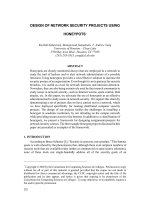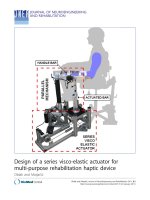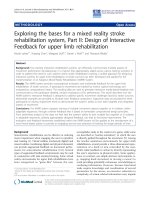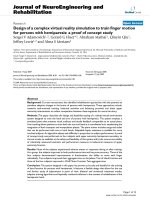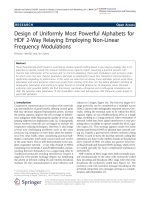Design of pipeline R2MDC FFT for implementation of MIMO OFDM transceivers using FPGA
Bạn đang xem bản rút gọn của tài liệu. Xem và tải ngay bản đầy đủ của tài liệu tại đây (2 MB, 8 trang )
Seediscussions,stats,andauthorprofilesforthispublicationat: />
DesignofpipelineR2MDCFFTfor
implementationofMIMOOFDMtransceivers
usingFPGA
ArticleinTelecommunicationSystems·November2016
DOI:10.1007/s11235-016-0136-8
CITATIONS
READS
0
53
2authors:
Dr.KirubanandasarathyN
KarthikeyanKottaisamy
SyedAmmalEngineeringCollege
ABB
28PUBLICATIONS21CITATIONS
9PUBLICATIONS68CITATIONS
SEEPROFILE
SEEPROFILE
AllcontentfollowingthispagewasuploadedbyDr.KirubanandasarathyNon04May2016.
Theuserhasrequestedenhancementofthedownloadedfile.Allin-textreferencesunderlinedinblueareaddedtotheoriginaldocument
andarelinkedtopublicationsonResearchGate,lettingyouaccessandreadthemimmediately.
Telecommun Syst
DOI 10.1007/s11235-016-0136-8
Design of pipeline R2MDC FFT for implementation of MIMO
OFDM transceivers using FPGA
N. Kirubanandasarathy1 · K. Karthikeyan1
© Springer Science+Business Media New York 2016
Abstract In this paper, an area-efficient low power Fast
Fourier Transform (FFT) processor is proposed for Multi
Input Multi Output—Orthogonal Frequency Division Multiplexing (MIMO-OFDM) that consists of a modified architecture of radix-2 algorithm which is described as Radix-2 multipath delay commutation (R2MDC). Orthogonal frequencydivision multiplexing is a popular method for high-data-rate
wireless transmission. OFDM may be combined with multiple antennas at both the access point and mobile terminal
to increase diversity gain and/or Enhance system capacity
on a time-varying multi path fading channel, resulting in a
multiple-input multiple-output OFDM system. This paper
describes the design of R2MDC FFT for implementation of
MIMO OFDM transceiver using FPGA targeted to future
wireless LAN systems. The proposed system is pipeline
Radix 2multipath delay commutation FFT has been designed
for MIMO OFDM. The MIMO OFDM transceivers have
been designed according to the proposed OFDM parameters.
A low-power efficient and full-pipeline architecture enables
the real-time operations of MIMO OFDM transceivers. The
FPGA board has been developed to verify their circuit behavior and implementation of MIMO OFDM Transceivers.
Keywords Radix-2 multipath delay commutation ·
Frequency division multiplexing · Multi input multi
output—orthogonal frequency division multiplexing ·
Inverse fast Fourier Transform · Fast Fourier Transform ·
Discrete Fourier Transform
B
N. Kirubanandasarathy
K. Karthikeyan
1
Department of ECE, Syed Ammal Engineering College,
Ramanathapuram, Tamilnadu, India
1 Introduction
Multiple input multiple output–Orthogonal frequency division multiplexing (MIMO-OFDM) has become a promising
technique for future mobile multimedia communication system because of its robustness to frequency selective fading
and its flexibility in handling multiple data rates [1,2].
MIMO-OFDM is the efficient solution for transmitting and
receiving the data over the long distance. The sub-carrier frequency has been chosen in our proposed OFDM transceivers
so that cross-talk between the sub-channels are eliminated,
hence the inter carrier guard bands are not required. The
orthogonally allows for efficient modulator and demodulator
implementation using the FFT algorithm. OFDM Transceivers is popular for wideband communications today by
way of low-cost MIMO OFDM Transceivers requires very
accurate frequency synchronization between the receiver
and they have their reduced the complexity In Transmitter;
with frequency deviation, the sub-carriers shall no longer
be orthogonal, causing inter-symbol interference (ISI). The
proposed FFT Processor is based on radix-2 multipath delay
commutation. We compare this proposed architecture with
existing radix 2 and radix 4 FFT and also give the design and
implementation results of the proposed FFF processor.
2 About MIMO OFDM
The general transceiver structure of MIMO OFDM is presented in Fig. 1. The system consists of N transmitter
antennas and M receiver antennas. Multiple antennas at both
sides of receiver and transmitter can improve the spectral
efficiency and reliability in multipath fading channels [3–5].
According to [6], the cyclic prefix is assumed to be a longer
than the channel delay spread. The OFDM signal for each
123
N. Kirubanandasarathy, K. Karthikeyan
Fig. 1 Architecture for MIMO-OFDM
antenna is obtained by using IFFT and can be detected by
fast Fourier transform (FFT). Each OFDM block of constellation symbols is transformed using an inverse fast Fourier
transform (IFFT) and transmitted by the antenna for its corresponding stream. The received signals at each antenna are
similarly broken into blocks and processed using an FFT.
[7].
Bolcskei et al have presented an OFDM based spatial multiplexing scheme, the data streams are first passed through
OFDM modulators and then launched from the individual
antennas. In the receiver, the individual signals are passed
through OFDM demodulators [8]. A powerful improvement
over conventional OFDM was the introductions of multicarrier code division multiplex (MC-CDM) OFDM by Kaiser
in [9]. In MC-CDM, rather than transmitting a single symbol on each subcarrier as in conventional OFDM, groups of
symbols are multiplexed together by means of orthogonal
spreading codes and simultaneously transmitted on a group
of subcarriers [10].
OFDM is a multi-carrier system where data bits are
encoded to multiple sub-carriers. Unlike single carrier systems, all the frequencies are sent simultaneously in time.
OFDM offers several advantages over single carrier system
like better multipath effect immunity, simpler channel equalization and relaxed timing acquisition constraints. But it is
more susceptible to local frequency offset and radio frontend non-linearity. The frequencies used in OFDM system
are orthogonal. Neighboring frequencies with overlapping
spectrum can therefore be used. This property is shown in
the Fig. 2, where A, B, C, D, and E orthogonal. This results
in efficient usage of BW. The OFDM is therefore able to
provide higher data rate for the same BW[11].
123
3 Proposed pipelined architecture
for MIMO-OFDM
The radix-2 multipath delay commutation (R2MDC) is one
of the commutated architectures of radix-2 FFT algorithm
which is used to commutate the values as fast as possible in
order to process the values and to commutate the FFT inputs,
the architecture shown in the Fig. 1 consists of different
blocks which must be used in the R2MDC. Kirubanandasarathy and Karthikeyan [12] have investigated Radix-2
pipelined streaming FFT block, which is used in the baseline
MIMO-OFDM system. But we use radix-2 multipath delay
commutation in the proposed system.
One of the most straightforward approaches for pipelined
implementation of radix-2 FFT algorithm is Radix-2 Multipath Delay Commutator (R2MDC) architecture. Figure 4
shows the radix-2 multipath delay commutation architecture
with butterfly II structure. It is the simplest way to rearrange
data for the FFT/IFFT algorithm, the input data sequence are
broken into two parallel data stream flowing forward, with
correct distance between data elements entering the butter-
Fig. 2 OFDM wave
Design of pipeline R2MDC FFT for implementation of MIMO OFDM transceivers using FPGA
Fig. 3 Proposed FFT architecture block
Fig. 4 Radix-2 multipath delay commutation architecture
Fig. 5 a BF I structure, b BF II structure
fly scheduled by proper delays. The 8-point FFT in R2MDC
architecture is shown in Fig. 3. At each stage of this architecture half of the data flow is delayed via the memory (Register)
and processed with the second half data stream.
The A input comes from the previous component twiddle
factor multipliers (TFM). The B output is fed to the next
component, normally BFII. In first cycles, multiplexors direct
the input data to the feedback registers until they are filled
(position “0”). On next cycles, the multiplexors select the
output of the adders/sub tractors (position “1”), the butterfly
computes a 2-point DFT with incoming data and the data
stored in the feedback registers. The detailed structure of
BFI is shown in Fig.5a.
123
N. Kirubanandasarathy, K. Karthikeyan
Fig. 6 FPGA implementation
of OFDM Transceiver
Fig. 7 OFDM transceiver
simulation wave form
The B input comes from the previous component, BFI.
The Z output is fed to the next component, normally TFM. In
first cycles, multiplexors direct the input data to the feedback
registers until they are filled (position “0”). On next cycles,
the multiplexors select the output of the adders/sub tractors
(position “1”), the butterfly computes a 2-point DFT with
incoming data and the data stored in the feedback registers.
The multiplication by –j involves real-imaginary swapping
and sign inversion. The real-imaginary swapping is handled
by the multiplexors MUX in efficiently and the sign inversion
is handled by switching the adding-subtracting operations by
mean of MUX. When there is a need for multiplication by -j,
all multiplexors switches to position “1”, the real-imaginary
data are swapped and the adding-subtracting operations are
switched.
The architecture of BFI and BFII supporting two receive
chains is shown in Fig. 5a, b. In BFI structure the sample
routing MUXs and DEMUXs at the input and output of the
BF_RAMs are controlled based on c2 and c3 control signals
123
while the computation unit is controlled by c1 control signal.
The control signals are issued by the BFI controller. Depending on the programming of number of receive chains the extra
BF_RAMs are enabled. WiMAX supports 1Rx and 2Rx, LTE
supports 1Rx, 2Rx and 4Rx. Based on the requirement extra
buffers can be extended to the existing BF structure.
The adders and substractors in BFI and BFII are fullypipelined and followed by divide-by-2 and rounding. The
divide-by-2 is used. The algorithm used here is to commutate
the radix-2 algorithm in the IFFT architecture and to replace
by R2MDC architecture in order to get a low area than the
existing system
4 FPGA implementation of MIMO OFDM
transceiver
The applications like signal processing and telecommunication require FFT implementations which can perform with
Design of pipeline R2MDC FFT for implementation of MIMO OFDM transceivers using FPGA
Table 1 Comparison results of proposed R2mdc IFFT architecture with
existing radix-2 and radix-4 architecture
Fig. 8 R2MDC FFT output implemetation in the FPGA Altera cyclone
II DE2 development board
less latency computations and small in size while exhibiting
less power consumption. These computational tasks are executed either by a single, high frequency embedded processor
or by using an Application Specific Integrated Circuit (ASIC).
Field Programmable Gate Arrays (FPGAs) and Application
Specific Integrated Circuits (ASIC) provide different values
to designers, and they must be carefully evaluated before
Methods
Slices
Luts
Power (W)
R2MDC FFT
198
152
1.175
Radix-2 FFT
320
432
2.179
Radix-4 FFT
296
148
2.112
choosing any one over the other. FPGA has been suggested
as an enabling technology [13] for the hardware platform as
they offer the potential of hardware-like performance coupled with software-like programmability [14].
The register transfer VHDL net list of the OFDM Transceiver, which is optimized for low power consumption and
ASIC implementation, is used as basic net list for mapping on
a Xilinx FPGA as shown in Fig 6. The DCM installs a zero
phase delay between the internal and external clock and this
allows using a FIFO interface operating on the clock edges
to transfer transmit data and received data. The FPGA implementation is optimized for power consumption by disabling
the main internal clock when a functional unit is not operational. This derived clock is the output signal of a buffered
Fig. 9 RTL schematic of R2MDC FFT
123
N. Kirubanandasarathy, K. Karthikeyan
Fig. 10 Comparison results of proposed R2MDC IFFT architecture with existing radix-2 and radix-4 architecture
AND gate with the main internal units. This was the case in
the equalizer where additional pipeline registers are added
in the divider and in the data path of described above, delay
between each butterfly board currently enables base band
transmission via ADCs and DACs as shown Fig. 6.
The FPGA board uses transmitter, receiver, and Viterbi
decoder functions implemented in the Xilinx FPGA. We
added interpolator, decimator, random signal generator, and
PC interface. The interpolator and decimator require 100MHz clock frequency and the other modules operate at the
half clock speed. This FPGA with PC interface is used for
displaying Bit Error Rate (BER) and Packet Error Rate (PER)
results and controlling the transceiver. We intend to execute
data transmission experiments in both base band and pass
band channels.
The simulation results for R2MDC FFT algorithms have
been tested practically by implementing in the Altera DE2 FPGA development board. The Quartus-II tool is used
to download the design in to FPGA development board. In
the FPGA board, the reset signal input is connected to the
rightmost switch. For the set binary inputs at the remaining
switches, after the process in the FPGA, the outputs are seen
in LED displays in the board. These FPGA outputs can also be
verified with simulation results obtained using MODELSIM.
The FPGA board has been developed to verify their circuit
behavior and implementation of MIMO OFDM Transceivers.
The below simulation diagram is for R2MDC as shown in
Fig. 7. The reset value is high and after some time period the
value is low. While in reset is high the input value does not
taken into the process. The output value is occurred when the
reset is low.
FPGA Altera cyclone II DE2 development board to illustrate the implementation of R2MDC FFT is as shown in
Fig. 8.
123
The register Transfer Logic schematic for R2MDC FFT
that is targeted to mapped on FPGA Altera cyclone II DE-2
is shown in Fig. 9.
5 Results
The prime objective is to construct a FFT in order to have low
power consumption and lesser area. The parameters (i) power
consumption (ii) Area occupancy were given due consideration for comparing the proposed FFT with other FFTs. We
have designed all coding using Hardware Description Language (HDL). To get power, and area report, we use Xilinx
ISE Design Suite 10.1 as synthesis tool and Model-Sim 6.3c
for simulation. The comparison of Radix-2 FFT and Radix4 with Proposed R2MDC FFT is shown in the Table 1 and
Fig. 10.The Proposed FFT gives better result than Radix-2
FFT and Radix-4 FFT in terms of area and power consumption as shown in the Table1 and Fig. 10.
6 Conclusion
We presented a R2MDC pipeline FFT as MIMO OFDM system with a 100-MHz bandwidth, which is an area-efficient
low power FFT processor for MIMO-OFDM transceivers
implementation using FPGA. The transceiver uses fullpipelined processing and provides operations at minimum
clock frequency. The performance of various FFT such as
Radix-2, Radix-4 and proposed R2MDC were carried out and
their performance were analyzed with respect to the number
of CLB slices, LUTs and Power consumption. We demonstrated transceiver architecture suitable for the advanced
OFDM system. In this paper, we conclude that the proposed
Design of pipeline R2MDC FFT for implementation of MIMO OFDM transceivers using FPGA
R2MDC architecture gives a lower area and less power than
the existing radix-2 and radix-4 algorithm architecture. The
proposed architecture shows that it can be used for low power
applications such as MIMO-OFDM transceiver.
References
1. Sampath, H., Talwar, S., Tellado, J., Erceg, V., & Paulraj, A. (2002).
A fourth generation MIMO-OFDM broadband wireless system:
design performance, and field trial results. IEEE Communications
Magazine, 40(9), 143–149.
2. Zelst, A., & Schenk, T. (2004). Implementation of a MIMO
OFDM-based wireless LAN system. IEEE Transactions on Signal Processing, 52(2), 483–494.
3. Heath, R, Jr, & Paulraj, A. (2005). Switching between diversity and
multiplexing in MIMO systems. IEEE Transactions on Communications, 53(6), 962–968.
4. Forenza, A., Pandharipande, A., Kim, H., & Heath, R. W, Jr. (2005).
Adaptive MIMO transmission scheme: exploiting the spatial selectivity of wireless channels. In: Proceedings of the IEEE VTC-spring
(Vol. 5, pp. 3188–3192).
5. Wei, Y. R., & Wang, M. Z. (2006). A practical transmit antenna
selection scheme with adaptive modulation for spatial multiplexing MIMO systems. In IEEE intl. conf. on inf. & commun. tech.,
ICTTA’06, April 2006 Syria. IEEE Transactions on Information
Theory, 2, 2119–2124.
6. Kirubanandasarathy, N., Karthikeyan, K. & Thirunadanasikamani,
K. (2010). VLSI design of mixed radix FFT for MIMO OFDM
in the wireless communication. In: Proceedings of the IEEE
International conference on communication computing control
technologies (pp. 98–102), October 7–9, 2010, Ramanathapuram,
India.
7. Blum, R. S., Li, Y. G., Winters, J. H., & Yan, Q. (2001). Improved
space time coding for MIMO-OFDM wireless communications.
IEEE Transactions on Communications, 49(11), 1873–1878.
8. Bolcskei, H., Gesbert, D., & Paulraj, A. J. (2002). On the capacity
of OFDM-based spatial multiplexing systems. IEEE Transactions
on Communication, 50(2), 225–234.
9. Kaiser, S. (2002). OFDM code-division multiplexing in fading
channels. IEEE Transactions on Communication, 50, 1266–1273.
10. Femenias, Guilleum, & Riera-Palou, Felip. (2008). Enhancing
IEEE 802.11n WLANs using group-orthogonal code-division multiplex. Telecommunication Systems (TSMJ), 38(1–2), 37.
11. Kirubanandasarathy, N., & Karthikeyan, K. (2013). VLSI Design
of Pipelined R2MDC FFT for MIMO OFDM transceivers. Journal
of Applied Sciences (JAS), Science Alert Publications, 13(1), 197–
200.
12. Kirubanandasarathy, N. & Karthikeyan, K. (2012). VLSI Design
and Implementation of MIMO OFDM system for wireless communication. European Journal of Scientific Research (EJSR), ISSN
1450-216X, 73(2), 269–277.
13. Tuttlbee, W.H. Software defined radio: Enabling technologies.
Wiley. ISBN 0470843187.
14. Coulton, P. & Carline, D. (2004). An SDR inspired design for the
FPGA implementation of 802.11a baseband system. In Proceedings of the IEEE international symposium on consumer electronics
(pp. 470–475), September 1–3, Reading, UK.
N.
Kirubanandasarathy
received the B. Eng. degree in
Electrical and Electronics Engineering from Madurai Kamaraj University, Madurai, India,
in 2002, the M. Eng. Degree
in Applied Electronics from
Anna University, Chennai, India
in 2004. He has completed
Ph.D. in ECE from St. Peter’s
Institute of Higher Education
and Research, Avadi, Chennai,
Tamilnadu, India in 2013. He is
currently working as an professor in Syed Ammal Engineering
college, Ramanathapuram, Tamilnadu, India and Pursuing the His fields
of interest include VLSI and Communication system.
K. Karthikeyan received the B.
Eng. degree in Electrical and
Electronics Engineering from
Madurai Kamaraj University,
Madurai, India, in 2002, the
M. Eng. degree in Power systems from Anna University,
Chennai, India, in 2004, and
the Ph.D. degree from Indian
Institute of Technology Madras,
Chennai, India, in 2008. Currently, he is Professor in the
Department of Electronics and
Communication Engineering of
Syed Ammal Engineering College, Ramanathapuram, Tamilnadu, India. His fields of interest include
Power quality, Power electronics applications in Power system and
VLSI Design.
123
View publication stats




